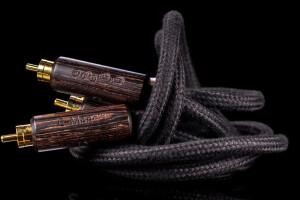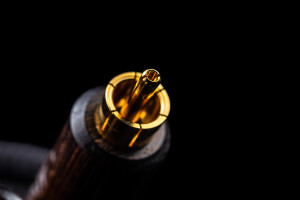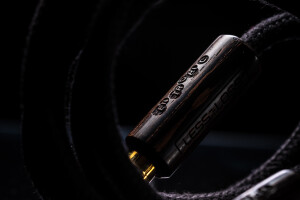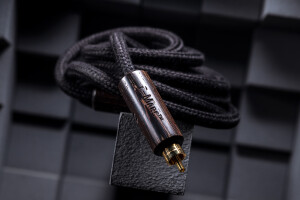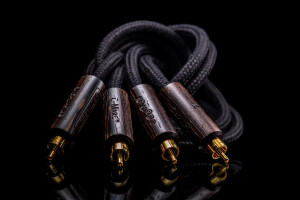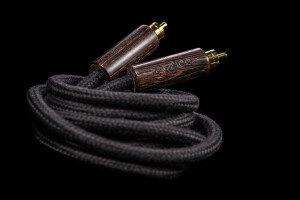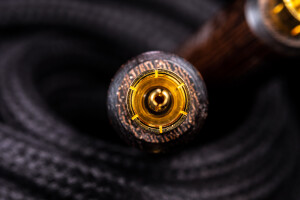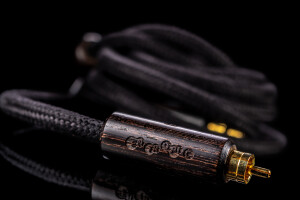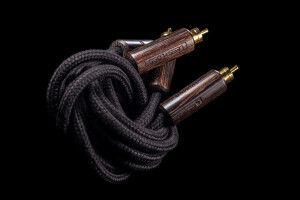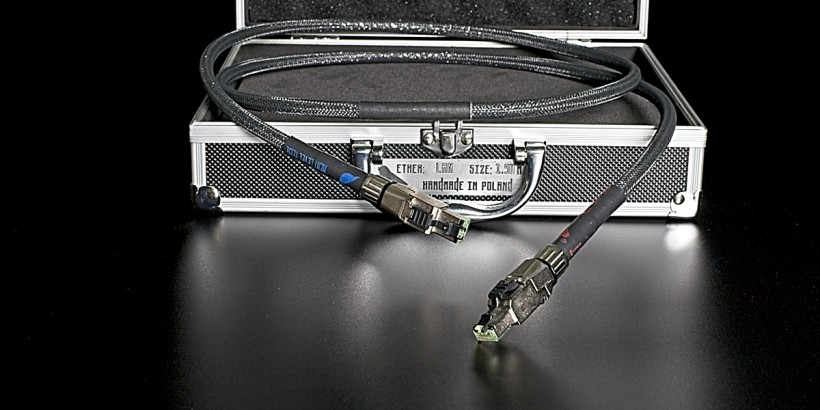LessLoss’ unique aging method that is gradually being applied across its existing roster just recently found its way to Entropic Process C-MARC RCA interconnects. I’ve been using these for several weeks in my main setup and now the time has come to go public with my findings. Enjoy!
SmartFi?
Upon seeing two identical audio cables would you believe right away in one’s noticeable sonic superiority? Until recently I wouldn’t either, but that changed immediately in the LessLoss C-MARC Entropic Process power cord reviewed here. Unpacked from a standard issue UPS envelope it looked, felt and behaved in hand exactly like its sibling I’ve been using for nearly three years. If it weren’t for the orange stickers inside the former’s plugs, my eyes really wouldn’t be able to tell these products apart, but my ears very quickly did. Although aural quietness with all its enjoyable benefits was their common ground, the latest C-MARC noticeably pushed the envelope on speed, directness, immediacy, spatial openness, clarity and oxygenation for a somewhat leaner profile that was sportier, more powerful, with less itchy top end and substantially better overall. This evolved sonic character equated with the easily traceable progress that many manufacturers would dress differently to visually separate old from new and create a multi-rung ladder of offers. However, at camp LessLoss technological advancements that lead to such quality leaps happen internally, so they remain unseen and don’t benefit from bling or any external makeover. The Lithuanians’ goods aren’t TrophyFi, but SmartFi, targeted to well-aware enthusiasts primarily focused on performance.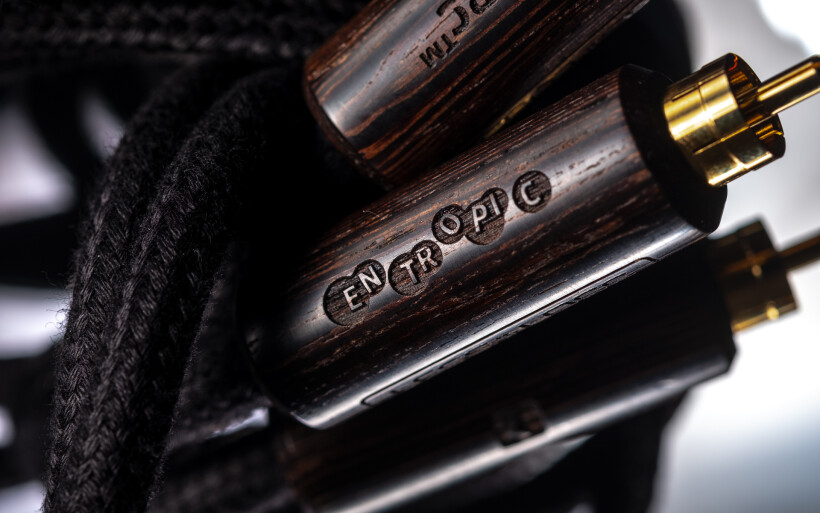 Now let’s take a detour towards LessLoss’ proprietary Entropic method that separates its newcomer C-MARC cables from their predecessors. It was designed to drastically age a conductor material so its internal structure changes and new properties develop along the way; in-built directionality and far lesser susceptibility to physical micro-vibrations for extra resilience to noise. Part and parcel of LessLoss’s proprietary Entropic Process is that it results in copper so soft that it can easily deform, which is why these Lithuanians’ first entropic-processed product – the Firewall for Loudspeakers – has its delicate internals locked in hard translucent resin barrels. The flexible Litz strands in C-MARC cables however have their individual conductive hairs protected by thin lacquer coats and are wrapped in layers of cotton, so they can undergo the Entropic treatment without any risk as they are meant to be flexible cables anyway. The measures used during that procedure are the company’s secret that probably involves specific chemicals, equipment, environmental controls and accuracy, but no regular current-based burn-in devices are used. The cryogenic treatment is used in all C-MARC products including basic non-Entropic models. Here it’s worth noting that LessLoss’ entropic-processed copper veins still will undergo burn-in, though at a much faster pace. They are claimed to net about two centuries’ worth of constant usage within a mere several weeks, so preserving their embedded factory-determined directionality is critical. In a sense, users are to complete what the Entropic Process has begun at LessLoss headquarters. Hence the manufacturer’s constant appeal for people to heed the directionality markings. This technology is applied to every stage of their common-mode noise-rejection geometry (aka C-MARC) from the very beginning of the manufacturing stage, so unprocessed LessLoss cables can’t be upgraded with it later on. Here let me encourage you to take a look at this Srajan’s article that has lots of extra info about the entropic subject.
Now let’s take a detour towards LessLoss’ proprietary Entropic method that separates its newcomer C-MARC cables from their predecessors. It was designed to drastically age a conductor material so its internal structure changes and new properties develop along the way; in-built directionality and far lesser susceptibility to physical micro-vibrations for extra resilience to noise. Part and parcel of LessLoss’s proprietary Entropic Process is that it results in copper so soft that it can easily deform, which is why these Lithuanians’ first entropic-processed product – the Firewall for Loudspeakers – has its delicate internals locked in hard translucent resin barrels. The flexible Litz strands in C-MARC cables however have their individual conductive hairs protected by thin lacquer coats and are wrapped in layers of cotton, so they can undergo the Entropic treatment without any risk as they are meant to be flexible cables anyway. The measures used during that procedure are the company’s secret that probably involves specific chemicals, equipment, environmental controls and accuracy, but no regular current-based burn-in devices are used. The cryogenic treatment is used in all C-MARC products including basic non-Entropic models. Here it’s worth noting that LessLoss’ entropic-processed copper veins still will undergo burn-in, though at a much faster pace. They are claimed to net about two centuries’ worth of constant usage within a mere several weeks, so preserving their embedded factory-determined directionality is critical. In a sense, users are to complete what the Entropic Process has begun at LessLoss headquarters. Hence the manufacturer’s constant appeal for people to heed the directionality markings. This technology is applied to every stage of their common-mode noise-rejection geometry (aka C-MARC) from the very beginning of the manufacturing stage, so unprocessed LessLoss cables can’t be upgraded with it later on. Here let me encourage you to take a look at this Srajan’s article that has lots of extra info about the entropic subject.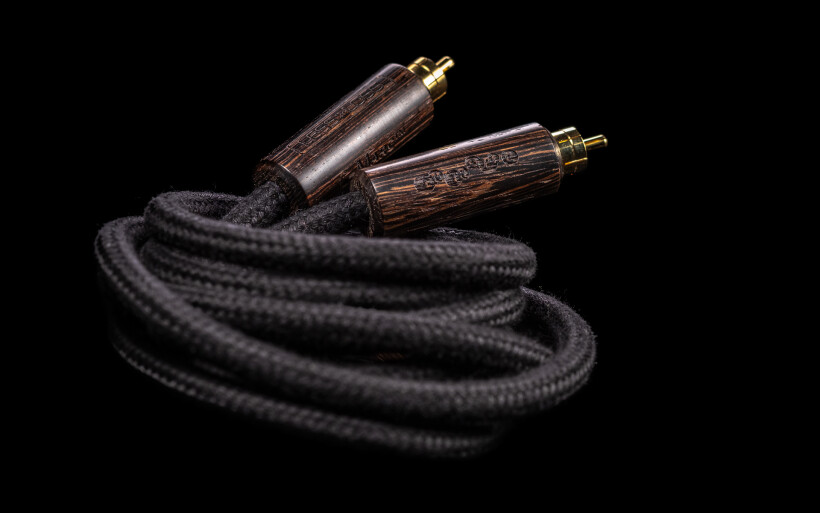 As for the C-MARC technology itself, it’s a unique geometry based on two counter-polarized, then fractally replicated coils of the same diameter and step; one turned clockwise and its equivalent twisted in the opposite direction. They superimpose mutually to form a unique bucking-coil connection originally developed in the 1930’s. Noise induced on these balanced strands is electrically cancelled due to their opposite polarity and geometry, which results in high S/N ratio and a particular type of silent backdrop. This report’s single RCA cable is comprised of 24 uncolored cotton fiber strands that form its core, surrounded by 192 copper conductive strands, each electrically isolated from one another, followed by 96 gassed and mercerized black cotton strands. The copper component is then replicated and sits under two black outer cotton layers made of 128 gassed mercerized strands each. One RCA run incorporates 760 strands of material, while its 384 enameled 0.125mm thin Litz wires form 4.608mm2 of total conductive cross-sectional area that is very low in terms of internal resistance.
As for the C-MARC technology itself, it’s a unique geometry based on two counter-polarized, then fractally replicated coils of the same diameter and step; one turned clockwise and its equivalent twisted in the opposite direction. They superimpose mutually to form a unique bucking-coil connection originally developed in the 1930’s. Noise induced on these balanced strands is electrically cancelled due to their opposite polarity and geometry, which results in high S/N ratio and a particular type of silent backdrop. This report’s single RCA cable is comprised of 24 uncolored cotton fiber strands that form its core, surrounded by 192 copper conductive strands, each electrically isolated from one another, followed by 96 gassed and mercerized black cotton strands. The copper component is then replicated and sits under two black outer cotton layers made of 128 gassed mercerized strands each. One RCA run incorporates 760 strands of material, while its 384 enameled 0.125mm thin Litz wires form 4.608mm2 of total conductive cross-sectional area that is very low in terms of internal resistance.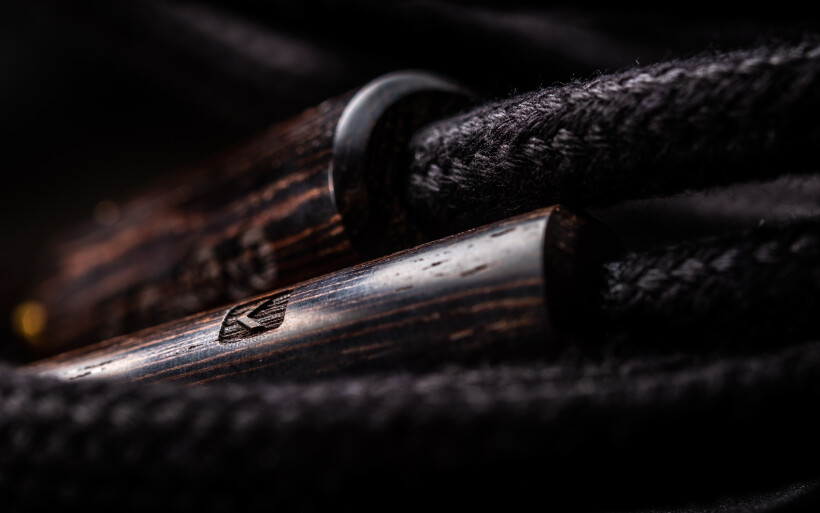 There’s no better time than now to mention that today’s loaner – the LessLoss Entropic Process RCA set – is its makers’ first interconnect that I’ve sampled, which means that any comparisons or references to its earlier non-Entropic version were off the table. This report’s product is a C-MARC nonetheless, so quite an inconspicuous specimen that’s mechanically very nimble. I found it exceptionally easy to use and realistically priced considering what it is. One 1.0m pair sells for $1’428. Should you need a single counterpart of the same length for digital, that’s $858. It’s the same coaxial cable after all, but its price reduces upon ordering longer runs and more of them. For some years LessLoss’ interconnects were terminated with Xhadow plugs but have now been replaced with those by ViaBlue. The Lithuanians say nay to any artificial materials wherever they can, so for this cable they use only the parts that make electrical contact and discard all else. Original barrels and plastic inserts of ViaBlue’s RCAs are here replaced with fabulously finished Wenge chucks, laser-engraved with four logos: LessLoss, Entropic, C-MARC and a directional arrow. These round, nicely polished cylinders are fairly thick, so checking first whether an electronic component’s sockets can accommodate them is advised. Their diameter is 17.5mm.
There’s no better time than now to mention that today’s loaner – the LessLoss Entropic Process RCA set – is its makers’ first interconnect that I’ve sampled, which means that any comparisons or references to its earlier non-Entropic version were off the table. This report’s product is a C-MARC nonetheless, so quite an inconspicuous specimen that’s mechanically very nimble. I found it exceptionally easy to use and realistically priced considering what it is. One 1.0m pair sells for $1’428. Should you need a single counterpart of the same length for digital, that’s $858. It’s the same coaxial cable after all, but its price reduces upon ordering longer runs and more of them. For some years LessLoss’ interconnects were terminated with Xhadow plugs but have now been replaced with those by ViaBlue. The Lithuanians say nay to any artificial materials wherever they can, so for this cable they use only the parts that make electrical contact and discard all else. Original barrels and plastic inserts of ViaBlue’s RCAs are here replaced with fabulously finished Wenge chucks, laser-engraved with four logos: LessLoss, Entropic, C-MARC and a directional arrow. These round, nicely polished cylinders are fairly thick, so checking first whether an electronic component’s sockets can accommodate them is advised. Their diameter is 17.5mm.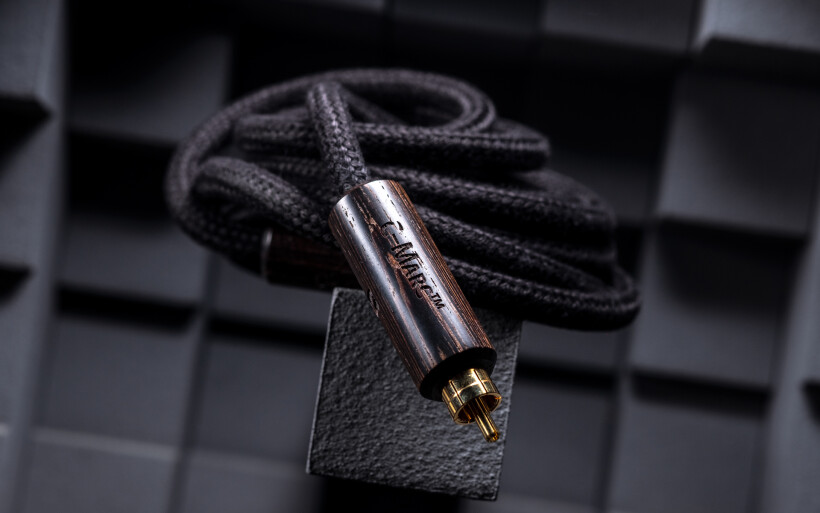 Here’s where the sound chapter should start, but instead of the usual profiling routine let me take you through some of my playlist’s tracks which I’ve been using during these listening tests. After all, that’s how each loaner product’s performance and character is mapped. This report’s LessLoss had just one sparring partner in the form of Audiomica Laboratory’s Amber-modded Erys Excellence ICs that replaced my stationary Boenicke Audio IC3 CG. Those quick to ask about the latter not participating this time around should know that it and the C-MARC Entropic Process reviewed here were both made by the same Lithuanian shop. The C-MARC technology put up against its upscaled version made for another company simply didn’t feel right.
Here’s where the sound chapter should start, but instead of the usual profiling routine let me take you through some of my playlist’s tracks which I’ve been using during these listening tests. After all, that’s how each loaner product’s performance and character is mapped. This report’s LessLoss had just one sparring partner in the form of Audiomica Laboratory’s Amber-modded Erys Excellence ICs that replaced my stationary Boenicke Audio IC3 CG. Those quick to ask about the latter not participating this time around should know that it and the C-MARC Entropic Process reviewed here were both made by the same Lithuanian shop. The C-MARC technology put up against its upscaled version made for another company simply didn’t feel right.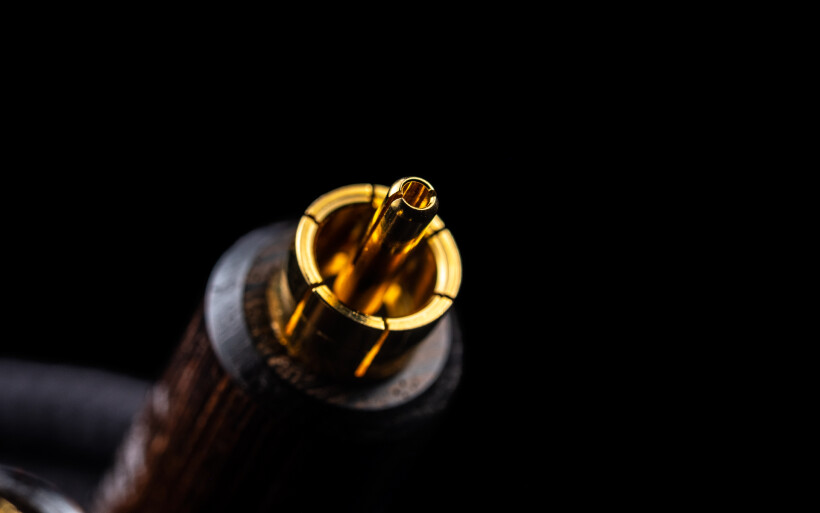 Both compared products saw my preamp’s RCA inputs, so their swaps required connecting either one or the other to the Pacific DAC and selecting their respective inputs on that pre. Let’s start with Eivør Pálsdóttir’s track “Verð Mín” built upon a large darkish background and her finely outlined female vocal supplemented by gentle bass pulses. After about a minute that song’s landscape significantly expands and delicate ethereal choirs step in to further boost its naturally dreamy soft atmosphere. The LessLoss rendered Eivør’s voice spot on delicate and fleshy yet distinct, precise and suspended in a breathing living space, while its gentle and meticulously if not cautiously served supportive bass line didn’t skip a beat and was fully controlled. Audiomica’s take on this job was noticeably slower, grainier, chiseled and with syrupy low end to at first seem more pronounced where it mattered most, but in time this glossy approach struck me as spicier yet not as resolving and surely not as clean. The more the two products clashed, the more the Lithuanian’s take emerged as evenly sorted across the entire audible range.
Both compared products saw my preamp’s RCA inputs, so their swaps required connecting either one or the other to the Pacific DAC and selecting their respective inputs on that pre. Let’s start with Eivør Pálsdóttir’s track “Verð Mín” built upon a large darkish background and her finely outlined female vocal supplemented by gentle bass pulses. After about a minute that song’s landscape significantly expands and delicate ethereal choirs step in to further boost its naturally dreamy soft atmosphere. The LessLoss rendered Eivør’s voice spot on delicate and fleshy yet distinct, precise and suspended in a breathing living space, while its gentle and meticulously if not cautiously served supportive bass line didn’t skip a beat and was fully controlled. Audiomica’s take on this job was noticeably slower, grainier, chiseled and with syrupy low end to at first seem more pronounced where it mattered most, but in time this glossy approach struck me as spicier yet not as resolving and surely not as clean. The more the two products clashed, the more the Lithuanian’s take emerged as evenly sorted across the entire audible range.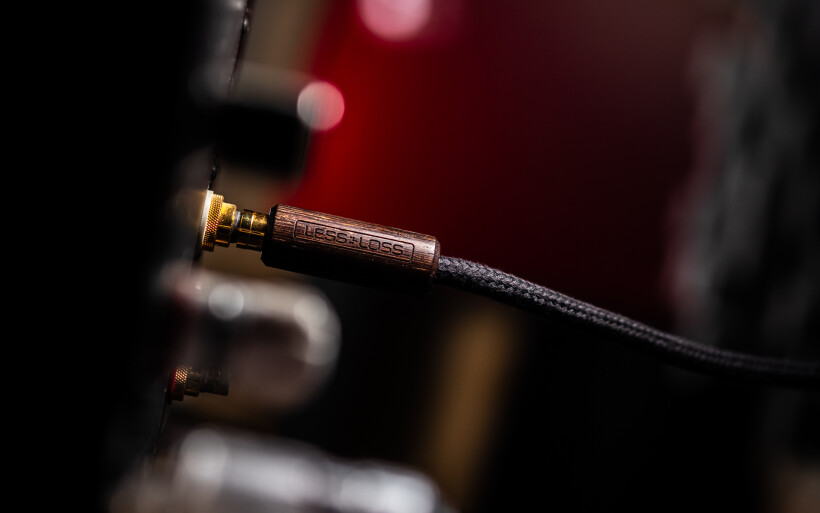 The same artist’s track “Trøllabundin,” structured even simpler than the previous one, features a vocal line and massive omnipresent bass blows presented on a somewhat haunting landscape. Eivør’s voice is the key focal point, but how it intersects with a large drum in that generously oxygenated spooky environment is key. This instrument that follows her high calm precise singing either makes or breaks the entire song. If it’s wobbly and bloated, all else suffers. Here the entropic C-MARC had the lady perfectly composed, outlined and textured in a way that was fleshy and free from any hints of nervousness. Audiomica’s ICs made her voice a bit higher and noticeably sharper at SPL above 80dB, but more importantly this interconnect’s noticeably bloomier character introduced a smear that diluted the supplementary bass line and made it lazier. Its arrival at a delay resulted in a fuzzier, less attractive outcome, while words yet again were excessively spicy, drier and less subtle. Moving on, at some point in this recording, Eivør’s voice, just a hair from the mic, transitions from naturally soothing and understandable into a more ominous growl. The local cable rendered it as more distant, contoured, slimmer and sharper while the LessLoss positioned it closer to one’s ears for a more realistic effect.
The same artist’s track “Trøllabundin,” structured even simpler than the previous one, features a vocal line and massive omnipresent bass blows presented on a somewhat haunting landscape. Eivør’s voice is the key focal point, but how it intersects with a large drum in that generously oxygenated spooky environment is key. This instrument that follows her high calm precise singing either makes or breaks the entire song. If it’s wobbly and bloated, all else suffers. Here the entropic C-MARC had the lady perfectly composed, outlined and textured in a way that was fleshy and free from any hints of nervousness. Audiomica’s ICs made her voice a bit higher and noticeably sharper at SPL above 80dB, but more importantly this interconnect’s noticeably bloomier character introduced a smear that diluted the supplementary bass line and made it lazier. Its arrival at a delay resulted in a fuzzier, less attractive outcome, while words yet again were excessively spicy, drier and less subtle. Moving on, at some point in this recording, Eivør’s voice, just a hair from the mic, transitions from naturally soothing and understandable into a more ominous growl. The local cable rendered it as more distant, contoured, slimmer and sharper while the LessLoss positioned it closer to one’s ears for a more realistic effect.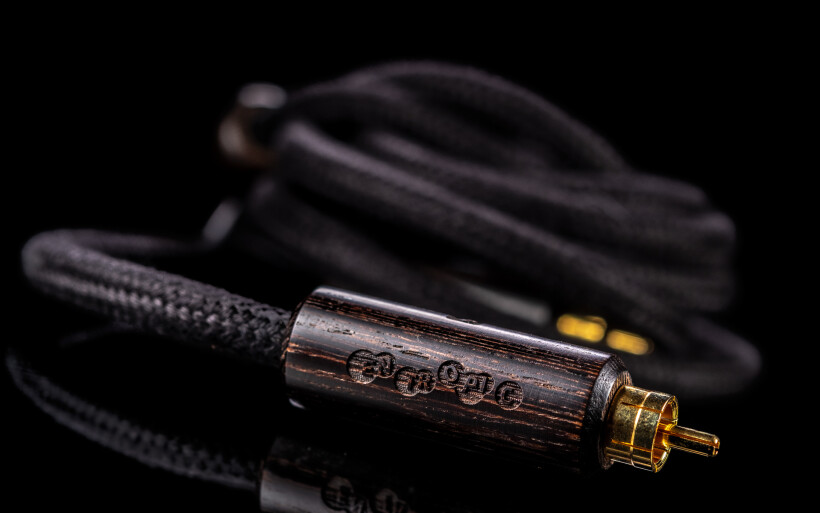 To follow with atmospheric minimalist repertoire, Carter Burwell’s “Blood Trails” piece from the “No Country for Old Men” soundtrack is a particularly interesting case that brilliantly builds anxiety early on. One can feel that something’s about to happen, but then a large chasm followed by a spatially big, calm, sensible acoustic guitar mellows everything for a more relaxed ride onwards. With the LessLoss engaged, that instrument’s every string pluck felt powerful, resonant, substantial and sustained, while Erys ICs made it internally hollow, shorter and less impactful in the process. Such delicate jobs require some amount of radiance and it’s fair to mention that the former product had less of that, but it didn’t seem any less clear, not at all. The newcomer C-MARC’s dosage of sun and earth struck me as applied more evenly and carefully, but the major difference was in how it portrayed rattles and quick swishing bits heard frequently on Burwell’s track. Here the Audiomica presented these sound sources as grainier and simpler, while its opponent rendered them smoother, weightier and lingering in the air a bit longer.
To follow with atmospheric minimalist repertoire, Carter Burwell’s “Blood Trails” piece from the “No Country for Old Men” soundtrack is a particularly interesting case that brilliantly builds anxiety early on. One can feel that something’s about to happen, but then a large chasm followed by a spatially big, calm, sensible acoustic guitar mellows everything for a more relaxed ride onwards. With the LessLoss engaged, that instrument’s every string pluck felt powerful, resonant, substantial and sustained, while Erys ICs made it internally hollow, shorter and less impactful in the process. Such delicate jobs require some amount of radiance and it’s fair to mention that the former product had less of that, but it didn’t seem any less clear, not at all. The newcomer C-MARC’s dosage of sun and earth struck me as applied more evenly and carefully, but the major difference was in how it portrayed rattles and quick swishing bits heard frequently on Burwell’s track. Here the Audiomica presented these sound sources as grainier and simpler, while its opponent rendered them smoother, weightier and lingering in the air a bit longer.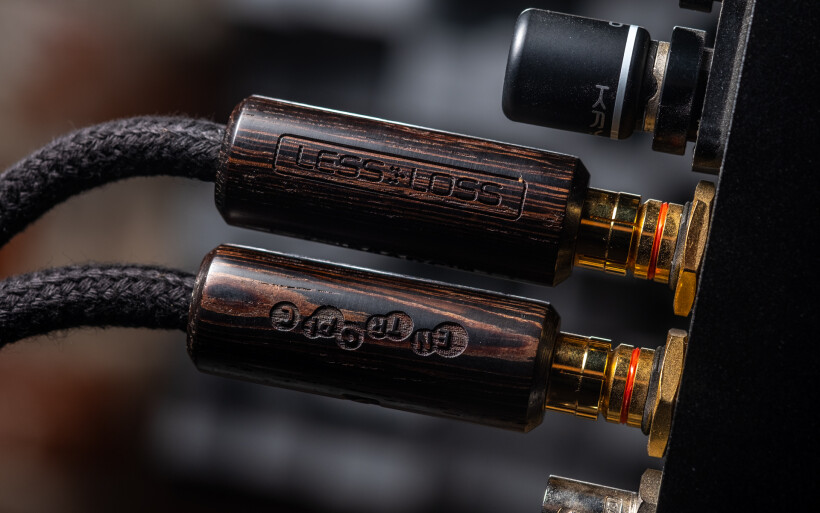 To speed things up a bit let’s move to “Temat Eleny na skrzypce” from the “Brute” soundtrack by Polish composer Michał Lorenc. This beautiful recording opens up with a single acoustic guitar, tambourine, drum and violin as the leading instrument. Everything’s fairly quiet and calm early on, but that song’s pace gradually increases throughout its entire duration to reach a wicked fast, dynamically enormous peak and high SPL. Here the line between claptrap and each virtual source properly loud and distinct is very thin. Any early sharpness at some point morphs into a piercing obstacle, and the sound|kaos Vox 3afw’s full-range transducers, inherently sensitive to grit and roughness, show all too well when that happens. On dynamic range, smoothness, instrumental hydration and fine soft edges, the LessLoss clearly took the cake without second guesses. Although I still couldn’t push the Swiss monitors too much, the Lithuanian IC set did a far better job than its edgier, slimmer and coarser sparring partner.
To speed things up a bit let’s move to “Temat Eleny na skrzypce” from the “Brute” soundtrack by Polish composer Michał Lorenc. This beautiful recording opens up with a single acoustic guitar, tambourine, drum and violin as the leading instrument. Everything’s fairly quiet and calm early on, but that song’s pace gradually increases throughout its entire duration to reach a wicked fast, dynamically enormous peak and high SPL. Here the line between claptrap and each virtual source properly loud and distinct is very thin. Any early sharpness at some point morphs into a piercing obstacle, and the sound|kaos Vox 3afw’s full-range transducers, inherently sensitive to grit and roughness, show all too well when that happens. On dynamic range, smoothness, instrumental hydration and fine soft edges, the LessLoss clearly took the cake without second guesses. Although I still couldn’t push the Swiss monitors too much, the Lithuanian IC set did a far better job than its edgier, slimmer and coarser sparring partner. Next let me introduce you to Michael Godard’s song “L’Abbesse” from his “Monteverdi – A Trace Of Grace” LP. Its characteristic Tuvan-like deep voice recorded within Abbaye de Noirlac’s thick medieval walls has always been the key attractor to me, or rather its transitions up and down across the vocal range. The word ‘moist’ ideally describes how today’s C-MARC handled that complex job, but its in-built silencing action also greatly contributed to rendering surrounding space on that track as breathing, touchable and three-dimensional for a very pleasant “alive” feel. Audiomica’s execution was more chiseled, shimmery, drier, and again with more lax low end control. Lesser vocal body and limited colors weren’t major offenders in the grand scheme of things, but the local cable’s spatial images staged mainly in front rather than around me, and that had a major impact on overall perspective. Impressions of tangible enveloping music projections demand nicely outlined virtual frames in front and partially also around a listener. On that specific front the LessLoss’ generously oxygenated moist aural bubbles contested with Audiomica’s more flat and uniform landscapes. In a word, the latter IC set showed me a regular picture from a distance, while the former rendered the same image closer and partially bent around, to effectively surround me by it to a larger degree.
Next let me introduce you to Michael Godard’s song “L’Abbesse” from his “Monteverdi – A Trace Of Grace” LP. Its characteristic Tuvan-like deep voice recorded within Abbaye de Noirlac’s thick medieval walls has always been the key attractor to me, or rather its transitions up and down across the vocal range. The word ‘moist’ ideally describes how today’s C-MARC handled that complex job, but its in-built silencing action also greatly contributed to rendering surrounding space on that track as breathing, touchable and three-dimensional for a very pleasant “alive” feel. Audiomica’s execution was more chiseled, shimmery, drier, and again with more lax low end control. Lesser vocal body and limited colors weren’t major offenders in the grand scheme of things, but the local cable’s spatial images staged mainly in front rather than around me, and that had a major impact on overall perspective. Impressions of tangible enveloping music projections demand nicely outlined virtual frames in front and partially also around a listener. On that specific front the LessLoss’ generously oxygenated moist aural bubbles contested with Audiomica’s more flat and uniform landscapes. In a word, the latter IC set showed me a regular picture from a distance, while the former rendered the same image closer and partially bent around, to effectively surround me by it to a larger degree. Nine Inch Nails’ track “The Wretched” from “The Fragile” album isn’t exactly a typical minimalist audiophile listen, but interestingly structured nonetheless. Each individual piano key struck early on feels massive, resonant and optically big, which builds a properly gloomy background for Trent Reznor’s unclear distorted voice. The man’s anger is evident and even more so in the chorus when electric guitars and additional effects step in. This track can get chaotic and messy very quickly, so instrumental separation, weight and all the piercing bits kept at bay are of paramount importance. Just as before, Audiomica’s ICs in my setup produced internally somewhat of a pale and sharp sound, while the Lithuanian cable’s input produced more cerebral and heftier guitars for a noticeably meatier, angrier and raw effect. This had all outlines in check and didn’t feel unclear at all. I don’t think that efficient lucid speakers such as those made by sound|kaos can entirely liberate “The Wretched” from needles, but the C-MARC made them sensibly less pointy and landed more pleasing, weightier sonics overall. That was a major win by my standards.
Nine Inch Nails’ track “The Wretched” from “The Fragile” album isn’t exactly a typical minimalist audiophile listen, but interestingly structured nonetheless. Each individual piano key struck early on feels massive, resonant and optically big, which builds a properly gloomy background for Trent Reznor’s unclear distorted voice. The man’s anger is evident and even more so in the chorus when electric guitars and additional effects step in. This track can get chaotic and messy very quickly, so instrumental separation, weight and all the piercing bits kept at bay are of paramount importance. Just as before, Audiomica’s ICs in my setup produced internally somewhat of a pale and sharp sound, while the Lithuanian cable’s input produced more cerebral and heftier guitars for a noticeably meatier, angrier and raw effect. This had all outlines in check and didn’t feel unclear at all. I don’t think that efficient lucid speakers such as those made by sound|kaos can entirely liberate “The Wretched” from needles, but the C-MARC made them sensibly less pointy and landed more pleasing, weightier sonics overall. That was a major win by my standards.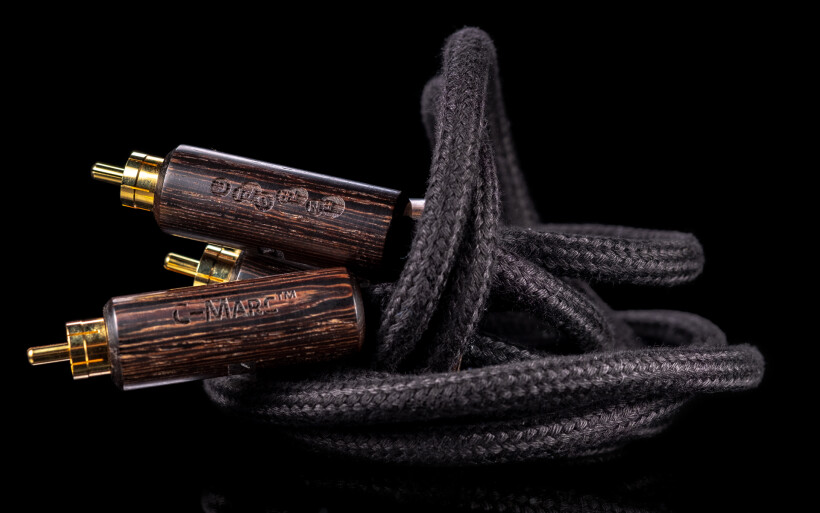 To liven things up a bit let’s move to “Festivo” from the “Zatoichi” soundtrack. Various drums, sticks, background vocals and clapping hands set the mood for a speedy, snappy, upbeat ride that’s by design highly entertaining and alive. As per usual with such recordings, their elastic open vibe, textural flavors and instrumental separation are essential. Here the LessLoss was more connected, coherent, heftier and nimble, while Erys ICs were glossier, hotter upstairs so sunnier in general, but also noticeably hollow in the midband, lazier on bass, more chiseled above and its textural palette wasn’t as differentiated. I didn’t have to listen to “Fastivo” twice to know which result was more enjoyable and balanced.
To liven things up a bit let’s move to “Festivo” from the “Zatoichi” soundtrack. Various drums, sticks, background vocals and clapping hands set the mood for a speedy, snappy, upbeat ride that’s by design highly entertaining and alive. As per usual with such recordings, their elastic open vibe, textural flavors and instrumental separation are essential. Here the LessLoss was more connected, coherent, heftier and nimble, while Erys ICs were glossier, hotter upstairs so sunnier in general, but also noticeably hollow in the midband, lazier on bass, more chiseled above and its textural palette wasn’t as differentiated. I didn’t have to listen to “Fastivo” twice to know which result was more enjoyable and balanced.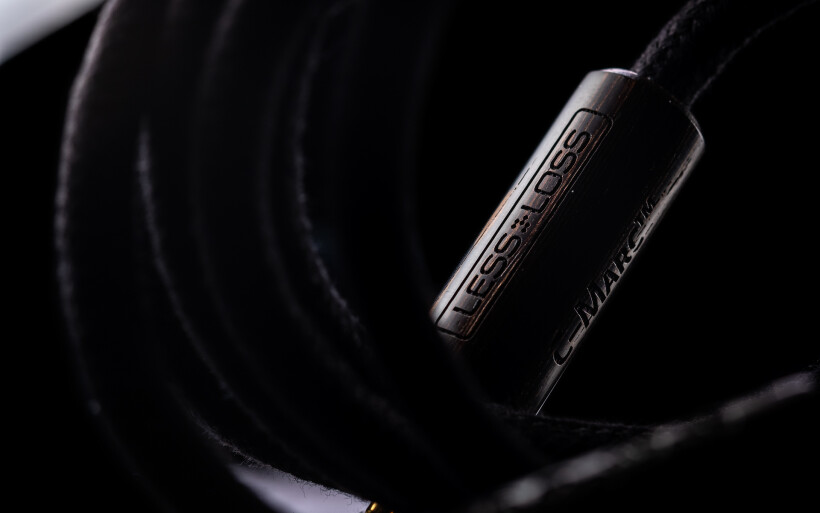 Johnny Cash’s cover of the song “Hurt” turned out so good that the Nine Inch Nails’ front man himself, who originally wrote it many years earlier, said it’s no longer his. Both the video and Cash’s voice are as mesmerizing as they’re sad and painful. Well, at least that’s the effect this monumental recording has on me and each time after experiencing it I need a moment to get my act together. It’s impressive how many contradicting and strong emotions just one singer and two instruments can invoke. Cash’s every word has tremendous weight, while an acoustic guitar and piano that follow are sensibly as powerful as the entire track. The C-MARC made it substantial, vibrant and mighty without subtracting anything from its original character, whereas with Erys ICs engaged it sounded shinier, slimmer, somewhat happier, less resonant and not as majestic, while the magnitude of these changes was the clincher. By now it should be apparent which interconnect set scored higher on firm instrumental structures and humane artful vocal line.
Johnny Cash’s cover of the song “Hurt” turned out so good that the Nine Inch Nails’ front man himself, who originally wrote it many years earlier, said it’s no longer his. Both the video and Cash’s voice are as mesmerizing as they’re sad and painful. Well, at least that’s the effect this monumental recording has on me and each time after experiencing it I need a moment to get my act together. It’s impressive how many contradicting and strong emotions just one singer and two instruments can invoke. Cash’s every word has tremendous weight, while an acoustic guitar and piano that follow are sensibly as powerful as the entire track. The C-MARC made it substantial, vibrant and mighty without subtracting anything from its original character, whereas with Erys ICs engaged it sounded shinier, slimmer, somewhat happier, less resonant and not as majestic, while the magnitude of these changes was the clincher. By now it should be apparent which interconnect set scored higher on firm instrumental structures and humane artful vocal line.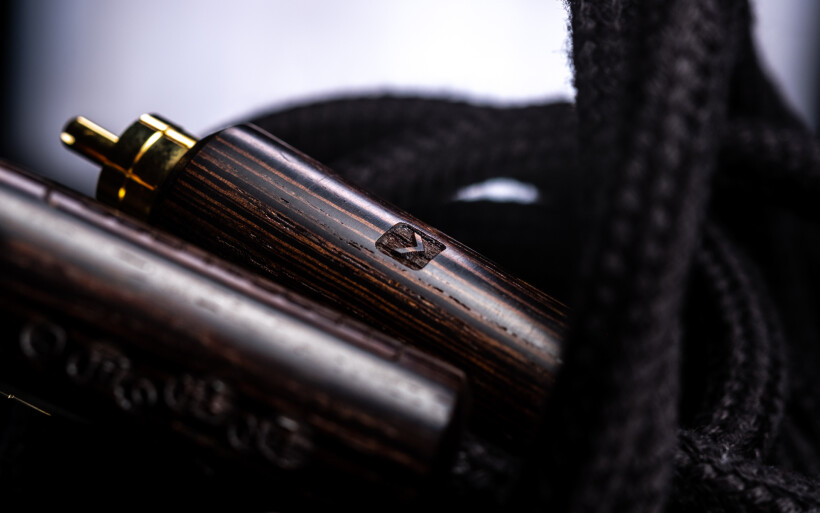 It’s tempting to press on with my daily music diet and pen extra words about its ingredients by i.e. Wardruna, Dead Can Dance, Blixa Bargeld, Mike Oldfield, Colin Stetson or Swans, and then throw in several guilty pleasures from the metal realm on top of that, but let’s stop here. I believe that the selection above rather well explains how this report’s entropic-processed LessLoss goes about its business. This fully-fledged C-MARC is geared for a particularly fetching silence and associated spatial blackness upon which all else blossoms. Its kind doesn’t flaunt any specific features other than this one, but if applied as generously it’s in fact more than enough to elevate performance of a vast majority of setups I can think of, and keep any listening fatigue at the door. C-MARCs by default are tonally even and safe, the risk of their counter-productive input is vanishingly low. Audio systems abnormally thick, slow and fuzzy perhaps would benefit more from connective veins tailored specifically for lucidity, openness and quickness as more potent countermeasures for these issues, but that’s about it. In this context today’s product wasn’t designed to repair, but rather support a sonic outcome already achieved and to preserve and cherish its character.
It’s tempting to press on with my daily music diet and pen extra words about its ingredients by i.e. Wardruna, Dead Can Dance, Blixa Bargeld, Mike Oldfield, Colin Stetson or Swans, and then throw in several guilty pleasures from the metal realm on top of that, but let’s stop here. I believe that the selection above rather well explains how this report’s entropic-processed LessLoss goes about its business. This fully-fledged C-MARC is geared for a particularly fetching silence and associated spatial blackness upon which all else blossoms. Its kind doesn’t flaunt any specific features other than this one, but if applied as generously it’s in fact more than enough to elevate performance of a vast majority of setups I can think of, and keep any listening fatigue at the door. C-MARCs by default are tonally even and safe, the risk of their counter-productive input is vanishingly low. Audio systems abnormally thick, slow and fuzzy perhaps would benefit more from connective veins tailored specifically for lucidity, openness and quickness as more potent countermeasures for these issues, but that’s about it. In this context today’s product wasn’t designed to repair, but rather support a sonic outcome already achieved and to preserve and cherish its character.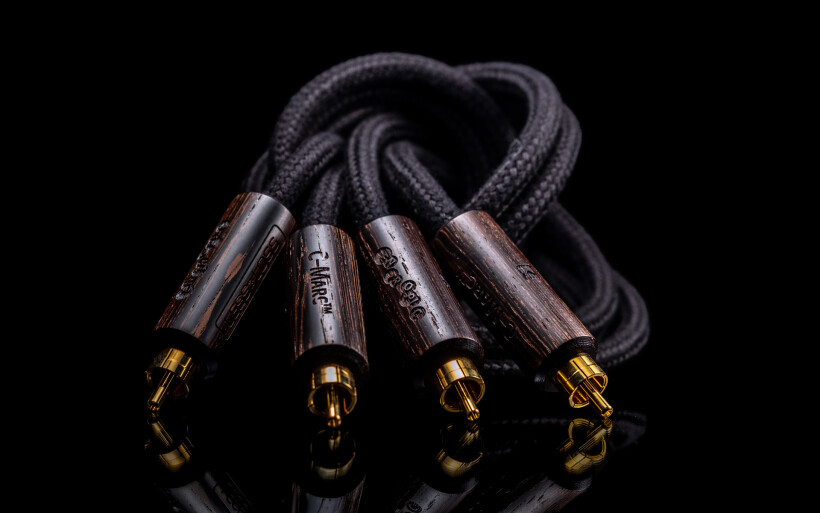 Various C-MARCs I’ve been using for some three years or so are keepers for a number of reasons. As a reviewer for a living, I appreciate their highly universal input and a loaner product from LessLoss clearly not fit for this is yet to come, but more importantly these Lithuanian cables and filters have been working extremely well in my main audio system. LampizatOr Pacific DAC, Boenicke W11 SE+ floorstanders and sound|kaos Vox 3afw monitors lean towards luminosity, quickness and openness, Trilogy’s 915R/995R set is in large part voiced oppositely and Innuos Statement’s profile is roughly in-between. Their flavors mixed together form a delicate sonic equilibrium maintained by accessories and cables is such that in aggregate it doesn’t steer towards i.e. higher clarity at a cost of heft or vice versa. For me personally it’s just a matter of either keeping that setup’s overall balance as is, or increasing its performance without penalties if possible. In this context, today’s highly organic and resolving entropic-processed RCA set did a splendid job. Just as its siblings, it didn’t demand anything specific in return for its arsenal of universally useful traits, and proved far less situational than most cables I’ve come across. Its wooden laser-engraved bullets turn it into one gorgeous looker that’s also exceptionally slinky, so it’s very easy to use. Individuals who constantly swap cables will appreciate its utmost obedient mechanical behavior. All that however still doesn’t quite tell what kind of a product it truly is.
Various C-MARCs I’ve been using for some three years or so are keepers for a number of reasons. As a reviewer for a living, I appreciate their highly universal input and a loaner product from LessLoss clearly not fit for this is yet to come, but more importantly these Lithuanian cables and filters have been working extremely well in my main audio system. LampizatOr Pacific DAC, Boenicke W11 SE+ floorstanders and sound|kaos Vox 3afw monitors lean towards luminosity, quickness and openness, Trilogy’s 915R/995R set is in large part voiced oppositely and Innuos Statement’s profile is roughly in-between. Their flavors mixed together form a delicate sonic equilibrium maintained by accessories and cables is such that in aggregate it doesn’t steer towards i.e. higher clarity at a cost of heft or vice versa. For me personally it’s just a matter of either keeping that setup’s overall balance as is, or increasing its performance without penalties if possible. In this context, today’s highly organic and resolving entropic-processed RCA set did a splendid job. Just as its siblings, it didn’t demand anything specific in return for its arsenal of universally useful traits, and proved far less situational than most cables I’ve come across. Its wooden laser-engraved bullets turn it into one gorgeous looker that’s also exceptionally slinky, so it’s very easy to use. Individuals who constantly swap cables will appreciate its utmost obedient mechanical behavior. All that however still doesn’t quite tell what kind of a product it truly is.
Last words
Audiomica’s hotter, more juvenile and uneven IC set was a punching bag for today’s C-MARC that scored far more points on ease of delivery, detail retrieval, smoothness, color range, sensible ambience, tangibility, control and dynamic contrasts. The latter’s superiority across pretty much the entire gamut wasn’t exactly a shock. It had a profound potency and subsequent impact on my setup, as if being spatially extremely gifted, properly radiant, sensual, articulate and earthy at the same time still wasn’t enough. Come to think of it, perhaps I shouldn’t be surprised, after recently witnessing what the Lithuanian’s Entropic Process did to their power C-MARCs and how much progress it actually secured. Now I can happily report that this same aging therapy, here applied to low-level signals, produces no less spectacular effects, simple as that. ‘Til next time!
Associated Equipment:
- Amplifier: Trilogy 995R
- DAC: LampizatOr Pacific (KR Audio T-100 / Living Voice 300B + KR Audio 5U4G Ltd. Ed.), Denafrips Terminator Plus
- Speakers: Boenicke Audio W11 SE+, sound|kaos Vox 3afw
- Transport: Innuos Statement
- Preamplifier: Trilogy 915R
- Speaker cables: Boenicke Audio S3, LessLoss C-MARC
- Speaker signal conditioning: LessLoss Firewall for Loudspeakers
- Interconnects: Audiomica Laboratory Amber-modded Erys Excellence, Furutech XLRs
- Power components: Gigawatt PC-3 SE EVO+/LC-3 EVO, LessLoss C-MARC, Boenicke Audio Power Gate, iFi audio PowerStation, ISOL-8 Prometheus
- USB components: iFi audio Mercury3.0
- Rack: Franc Audio Accesories Wood Block Rack
- Network: Fidelizer EtherStream, Linksys WRT160N
- Music: NativeDSD
Retail prices of reviewed components in EU (incl. tax):
- LessLoss Entropic Process C-MARC RCA set: $1’428/1.0m/pr, $1’688/1.5m/pr, $1’948/2.0m/pr, $2’210/2.5m/pr, $2’470/3.0m/pr
Manufacturer: LessLoss



